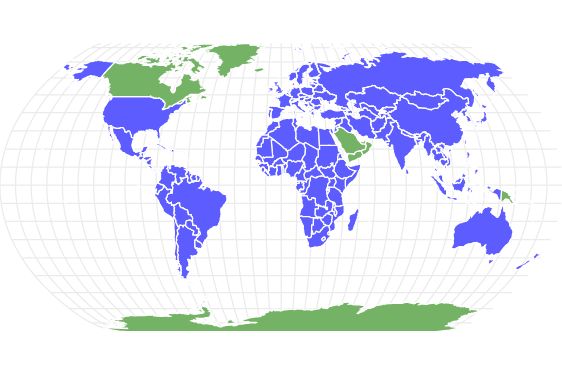Huntsman Spider
Some huntsman spiders have an interesting way of moving around. Some cartwheel while others do handsprings or backflips.
Advertisement
Huntsman Spider Scientific Classification
Read our Complete Guide to Classification of Animals.
Huntsman Spider Conservation Status
Huntsman Spider Facts
- Prey
- Insects, small mammals, other spiders, small lizards
- Name Of Young
- Spiderlings or hatchlings
- Group Behavior
- Sociable
- Fun Fact
- Some huntsman spiders have an interesting way of moving around. Some cartwheel while others do handsprings or backflips.
- Estimated Population Size
- At least hundreds of thousands worldwide.
- Biggest Threat
- Humans, geckos, birds, parasites
- Most Distinctive Feature
- Its size
- Other Name(s)
- Wood spider, rain spider, lizard eating spider, giant crab spider
- Litter Size
- 100 to 200 young
- Habitat
- Warmer areas of the world
- Predators
- Birds, geckos, spider wasps
- Diet
- Carnivore
- Type
- Arachnid
- Common Name
- Huntsman spider
- Number Of Species
- 1382
- Location
- Oceania, North, South and Central America, Asia, Africa, north and central Europe and the Mediterranean.
View all of the Huntsman Spider images!
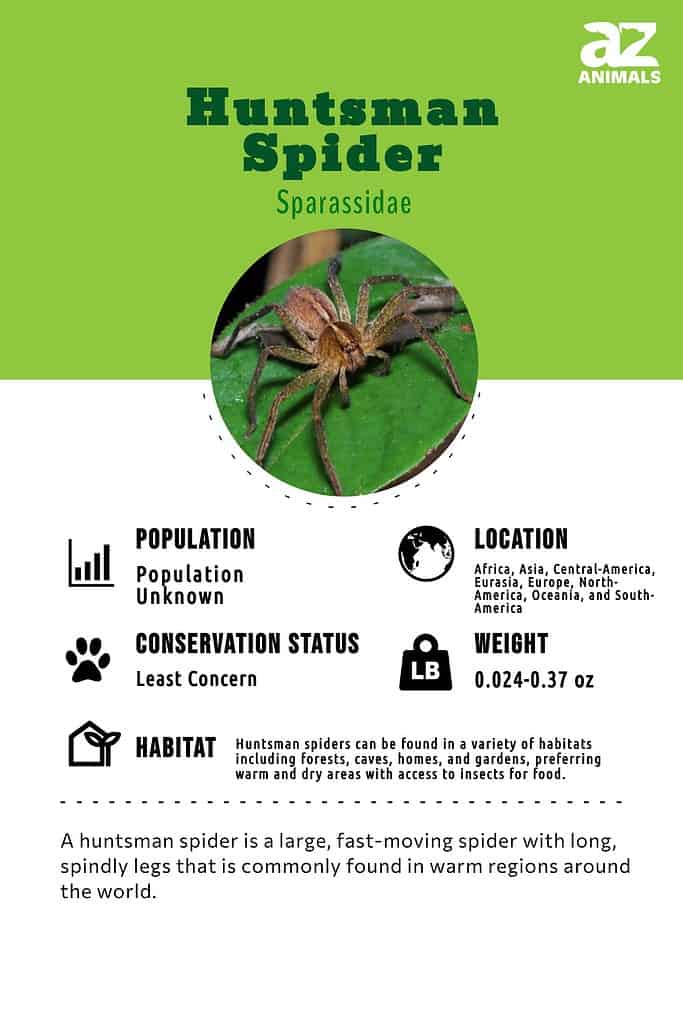
The largest spider by leg span in the world.
Huntsman spiders belong to the Sparassidae family and get their common name because they are efficient and lethal hunters.
There are 96 genera and 1383 species as of 2021. They are usually large, hairy spiders that hold their legs crabwise, which gives them the alternate name of giant crab spider. Most are gray or brown but may have bands and markings over their legs and bodies.
They have eight eyes and fairly good eyesight. Like other spiders, they are venomous as opposed to poisonous, and some are capable of inflicting painful bites on human beings.
But like other spiders, their venom evolved to subdue their regular prey. Some people welcome huntsman spiders in their homes because they eat pests such as cockroaches.
4 Incredible Huntsman Spider Facts!
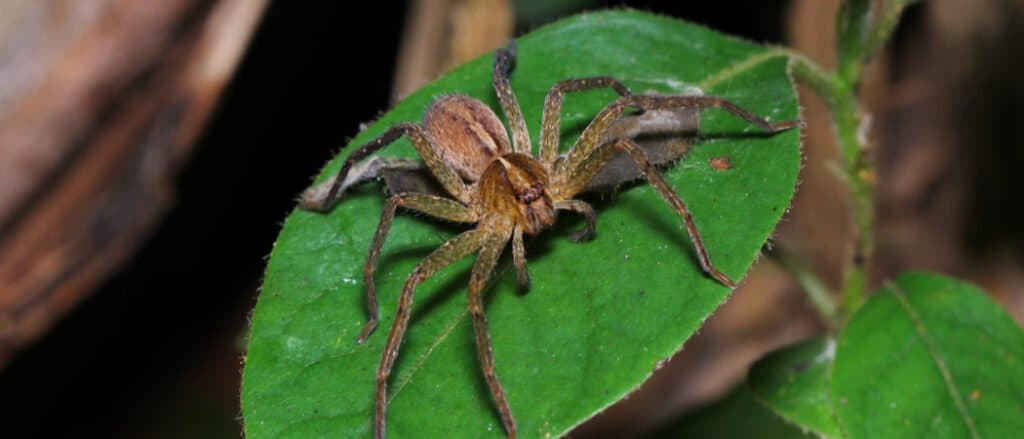
The eggs and young of female huntsman spiders are carefully guarded by them.
©Pong Wira/Shutterstock.com
- Huntsman spiders are surprisingly gentle during courtship. Males in many species drum their abdomens or their legs on the ground to create vibrations that are interesting to the females, who lure them with pheromones.
- Female huntsman spiders are fiercely protective of both their eggs and their young. They keep their eggs in a sac or purse made of silk and will either stand guard over it or carry it in their jaws. When the eggs hatch, she’ll guard the spiderlings until they molt several times. This can take weeks, and during that time the mother spider doesn’t eat.
- While some huntsman spiders are solitary, others live happily in large colonies.
- Though huntsman spiders don’t spin webs, they’ll spin a sort of cocoon out of silk when it’s time for them to molt or lay eggs.
Evolution and Origins
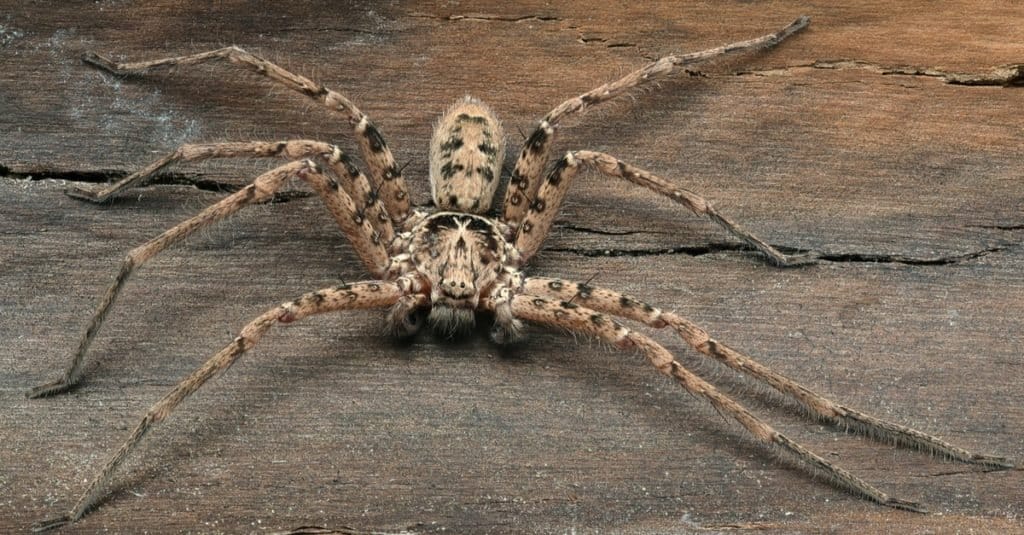
The world’s biggest spider, the Giant Huntsman Spider, are not harmless to human but will bite if provoked.
©iSKYDANCER/Shutterstock.com
The origin of the huntsman spider is traced back to Asia, where its nearest kin can be found. Nonetheless, it is theorized that the spider was brought to the United States through banana shipments from Central America.
Huntsman spiders are present in numerous states and territories throughout Australia, so there is a good chance of encountering them. During warm weather or rainfall, they are frequently spotted indoors on walls and ceilings.
Sparassidae, previously referred to as Heteropodidae, constitute a spider family commonly recognized as huntsman spiders. This is owing to their agility and style of hunting. Additionally, their size and physical characteristics earn them the name of giant crab spiders.
Different Types
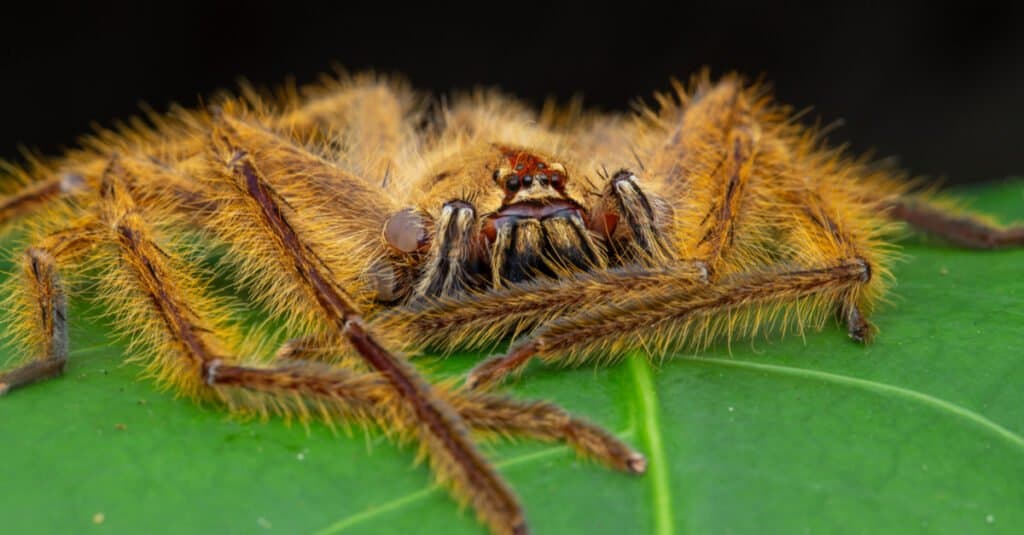
There are 17 different types of huntsman spiders.
©Alen thien/Shutterstock.com
Different types of huntsman siders:
- Giant huntsman spider
- Huntsman spider
- Micrommata virescens
- Heteropoda
- Olios
- Eusparassus
- Palystes superciliosus
- Wheel spider
- Delena
- Heteropoda davidbowie
- Cerbalus aravaensis
- Pandercetes
- Thelcticopis
- Leucorchestris arenicola
- Curicaberis
- Pseudopoda
- Paenula
Huntsman Spider Species, Types, and Scientific Name
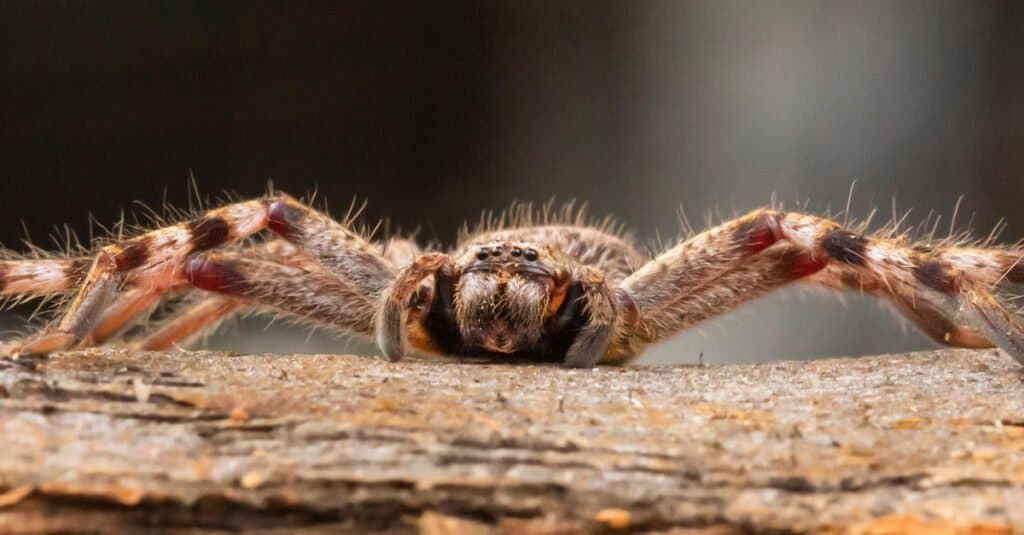
The Sparassidae family, which is divided into categories of genera and species, is where the huntsman spider is classified.
©Wright Out There/Shutterstock.com
The classification of the huntsman spider puts them in the Sparassidae family, which is broken down into classifications of genera and species.
There are e nearly one hundred genera and over 1300 species of giant crab spiders. By the way, the Sparassidae family isn’t closely related to proper crab spiders, who are members of the Thomisidae family.
Among the genera are the:
- Carparachne: This genus contains the fascinating cartwheeling spider, Cebrennus rechenbergi. This spider actually cartwheels to get away from threats, and it’s the only spider known that does this. It’s found in Morocco and is also called the Moroccan flic-flac spider. A robot was actually built to mimic this spider’s movements.
- Diminutella: As its name suggests, this is one of the tiniest of these giant spiders. The body length of the female Diminutella cortina is only 0.14 to 0.17 of an inch. It is found in Cuba and is the only species in its genus.
- Heteropoda: The classification Heteropoda is a large genus that contains the brown huntsman, Heteropoda cervina. The genus gets its name because the legs of this giant arachnid are of unequal length, but this lets the spider scuttle sideways and change its direction quickly. The brown huntsman is known for living in houses in Queensland, Australia, but it is a timid spider that only bites when it’s threatened.
- Leucorchestris: This classification contains the dancing white lady, Leucorchestris arenicola of the Namibian desert. The spider communicates with conspecifics by drumming with its front legs. The way it drums must e precise, for another spider can mistake its vibrations for prey and kill the spider that’s trying to communicate with it. The dancing white lady can also use its eight eyes individually to give it panoramic vision.
- Micrommata: The spiders in this genus differ from other huntsman spiders in that many of them are bright green. This includes Micrommata virescens, a huntsman that lives in the woods of northern Europe.
Appearance
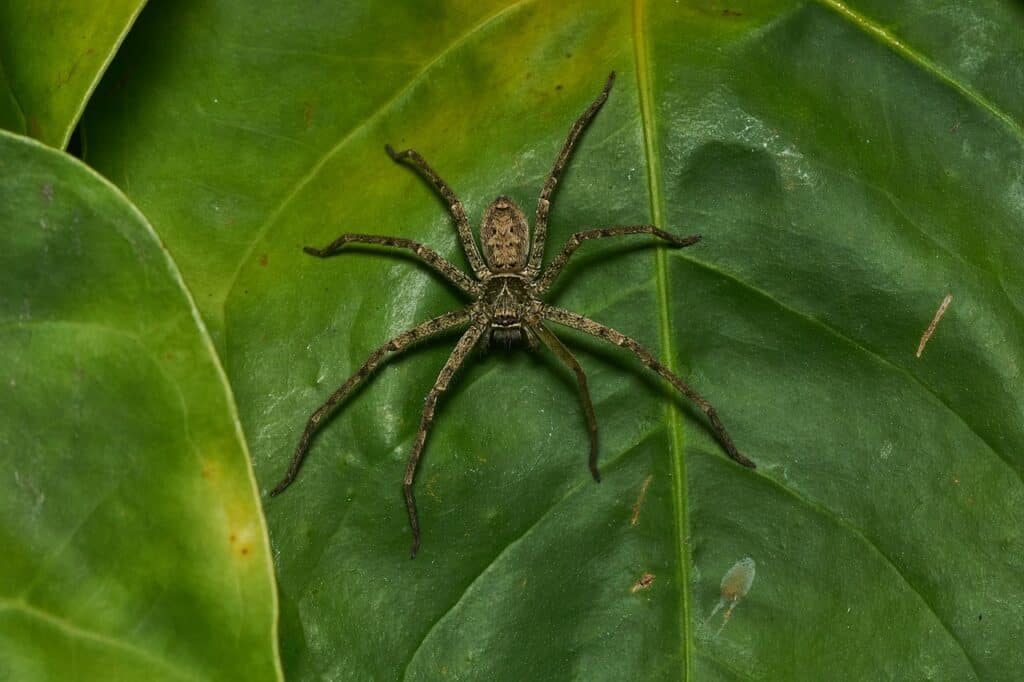
Pantropical huntsman spiders can measure nearly 12 centimeters long with their legs extended
©© 2017 Jee & Rani Nature Photography / CC BY-SA 4.0 via Wikimedia Commons – License
It is easy to say that to identify a huntsman spider all that a person needs to see is a giant spider that holds its legs like a crab. Yet, some species of huntsman spiders aren’t much bigger than regular crab spiders, and the brown recluse is also rather large and has a cancrine stance.
Crab spiders are also called flower spiders because they perch on flowers and ambush insects that light on the flowers. They can slowly change colors to blend in with the flower, but huntsman spiders can’t do this.
Most are shades of brown or gray, though some species in the Micrommata genus are leaf green. Huntsman spiders also tend to be furry, and they can easily hide in small spaces despite their size. This is because their bodies tend to be flat, and they have those uniquely foldable legs. They are ambush predators and can also move surprisingly fast for their size.
Habitat
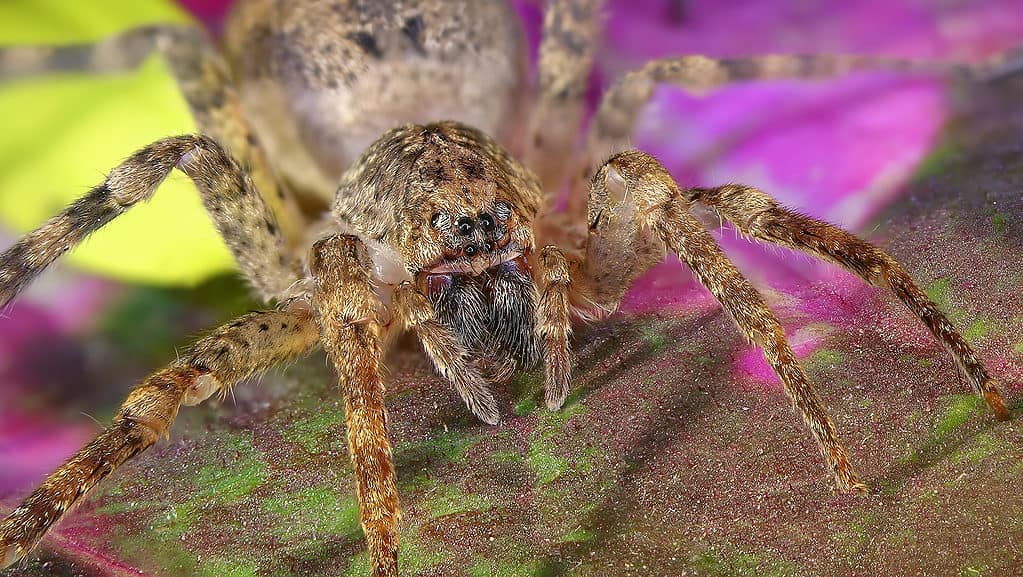
Huntsman spider, giant crab spider or cane spider, Heteropoda venatoria (Sparassidae) on a flower.
©Protasov AN/Shutterstock.com
Huntsman spiders are found around the world save the coldest areas on earth. They hide in places that don’t see a lot of human traffic, such as garages, barns, and garden sheds. Some hide behind blinds and curtains and startle people who have come to adjust their window dressings. Huntsman spiders also shelter in cars and also startle people who try to adjust their rearview mirror. In the wild, they’re found under bark and under rocks. This gives them the name “wood spider.”
Diet
Huntsman spiders usually eat small arthropods. They range from butterflies to cockroaches, and even scorpions. Some species eat other spiders and are indeed cannibalistic. Some huntsman spiders are big enough to take bats, mice, and small lizards.
Prevention
There are many people around the world who welcome huntsman spiders into their homes because they eat pests. These are not only roaches and water bugs, but if the spider is big enough, it can even keep down a population of mice.
Most huntsman spiders are docile and run away when they’re threatened. Yet it’s understandable if the homeowner really does not want giant poisonous spiders in their home. In that case, it is possible to call in a pest control expert and have them trapped and humanely removed.
View all 104 animals that start with HHuntsman Spider FAQs (Frequently Asked Questions)
Are Huntsman Spiders dangerous?
Huntsman spiders aren’t really dangerous. They are venomous as opposed to poisonous, and though the bite of some huntsman spiders is painful, the bite usually doesn’t require a person to go to a hospital.
How many legs does a huntsman spider have?
A huntsman spider has eight legs.
How do you identify a huntsman spider?
Generally, huntsman spiders are large spiders that hold their legs as a crab would hold them. They don’t build webs but are very fast. They can quickly run across a floor, up a wall, and even across the ceiling. They usually (but do not always) come in shades of gray or brown.
How do you get rid of huntsman spiders?
If a person simply can’t live with a huntsman spider, it can be trapped humanely and let loose in the woods. Huntsman spiders are good for the environment and provide an inexpensive, indeed, free, form of pest control. People should avoid killing them.
Do huntsman spiders live in the US?
Some species of huntsman spiders are found in the United States. They include the Olios, Macrinus, Decaphora, and Curicaberis genera.
Can a huntsman spider kill you?
A huntsman spider’s bite can’t kill a healthy adult human being, but some spiders have venom that can make a person quite sick. Still, most people who are bitten by a giant crab spider don’t need to go to the hospital.
Are huntsman spiders friendly?
Huntsman or wood spiders may not be exactly friendly, but they do not go out of their way to attack humans. They are more interested in cockroaches and other prey they can handle.
Why is it called a huntsman spider?
The huntsman spider gets its name because it is good and quick at hunting its prey.
What is the average size of a huntsman spider?
The average huntsman spider has a 7.9-inch leg span, though male Heteropoda maxima, the giant huntsman spider of Laos, can have a leg span of nearly one foot.
How much does a huntsman spider weigh?
Depending on the species, a huntsman spider can weigh between 0.024 ounces and 0.37 pounds.
What's the largest species of huntsman spider?
The largest species of huntsman spider is the giant huntsman. These spiders were only discovered in 2001 and live in remote caves of Laos.
What are the key differences between huntsman spiders and wolf spiders?
The key differences between huntsman spiders and wolf spiders are appearance, behavior, and habitat.
Thank you for reading! Have some feedback for us? Contact the AZ Animals editorial team.
Sources
- Bug Guide, Available here: https://bugguide.net/node/view/6928
- Roaring Earth, Available here: https://roaring.earth/the-huntsman/
- Wikipedia, Available here: https://en.wikipedia.org/wiki/List_of_Sparassidae_species
- Kidadl, Available here: https://kidadl.com/animal-facts/huntsman-spider-facts
- Live Science, Available here: https://www.livescience.com/41428-huntsman-spider.html
- Australian Museum, Available here: https://australian.museum/learn/animals/spiders/huntsman-spiders/

